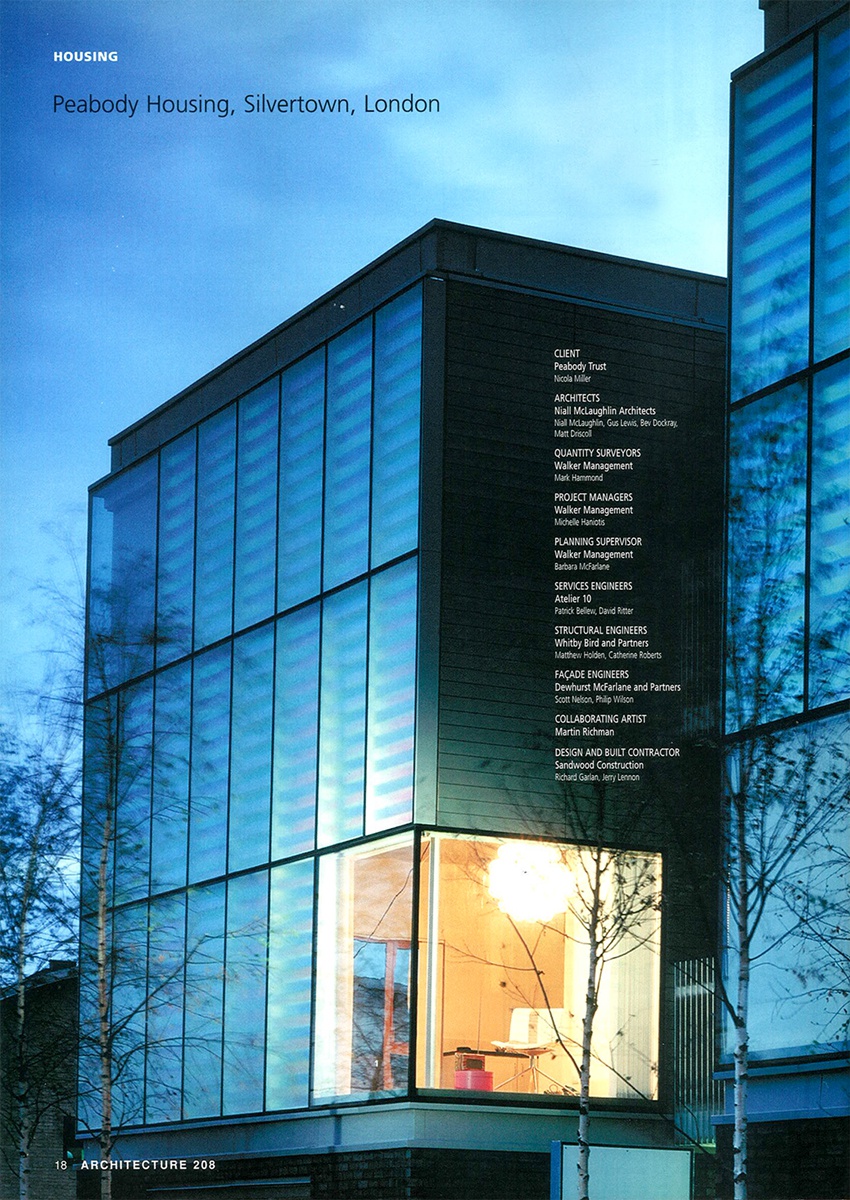Peabody Housing, Silvertown, London - Architecture Ireland
Issue 208, June 2005
Text Níall McLaughlin
Images Nick Kane
In December 2002, we won the Peabody Trust’s design competition called Fresh Ideas for Low Cost Housing. The practice always looks carefully into the history and topography of a site, as each location has something comparable to DNA, a coded trace pointing towards the future. This site was in Silvertown in East London, between Royal Victoria Dock and the River Thames, and had experienced an extraordinary flowering of industry from the time of the Great Exhibition in 1852 to the collapse of British manufacturing in the late 1970s. The glister in the name – Silvertown – comes from Stephen Winkworth Silver, who built a rubber plant on the site in 1852, manufacturing wet-weather clothing. Over the next 50 years, a remarkably consistent range of factories – making sugar, coloured dyes, jam, golden syrup, gutta percha, soda, TNT, soap and matches – sprung up. These factories manufactured chemical sweetness, colour and light.
Today the area is being repopulated by a rag-bag of yuppie-houses, airports, an IBIS hotel and a vast conference centre. this kind of place has been called a post-industrial landscape. We prefer to think of it in the context of emerging and dissolving landscapes. The uncertainty of its identity is the essence of the place. Its properties are fugitive.
In Silvertown, the factories lined the river and the warehouses lined the dock. In between lay a zone of industrial worker’s housing. It was low lying, squat and regular. Our site lies on the edge of Evelyn Road. Although the street is partly derelict now, it separated the houses from the warehouses. Our apartments are built on the warehouse side of the street. We concentrated on the following design issues:
– A rational layout of the interior with a large, flexible living space and unusually high ceilings for low cost housing.
– The view from the building, over the strange landscape of the London Docklands: London City Airport, Canary Wharf and the Millennium Dome.
– The strange ‘chemical history’ of the site.
– The nature of modern industrialised construction, in which a timber-frame is wrapped in a decorative outer layer.
Each living unit has two bedrooms and a shared bathroom. The kitchen, dining and living functions are accommodated within a single, large space on the south side of the building. This allows each apartment to make the most of the sun and the view. Ground floor units have a back garden while all other apartments have south-facing terraces.
Modern low cost housing construction is pre-fabricated timber frame and timber sheeting. We imagined our building being like a row of packing crates stacked up near the water. Once you make the timber carcass, you have to wrap it in something. This is usually a layer of brick, wood or tiles. The industrial product is returned to a reassuring traditional appearance. For our project we looked at different kinds of industrial wrapping that might be used as the final layer of our building. Given the site history, we wanted something bright and sweet and chemical. It also had to be inexpensive.
We collaborated with light artist Martin Richman for this project and he suggested a material called Radiant Light Film. It is produced by 3M, who make everything from dental adhesive to post-it-notes. It has dichroic properties so it produces iridescence. Colourless metal oxiding on the film surface disrupts the reflection of light, producing interference patterns that appear as colour. As the angle of incidence changes, the colour changes. The surface, the light source and the viewer are in an ever-changing relationship. The 18th century physicist and architect Auguste Fresnel discovered this effect and explained the phenomenon of iridescence. It appears naturally in petrol and peacocks wings.
